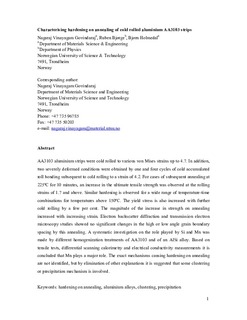Characterizing hardening on annealing of cold-rolled aluminum AA3103 strips
Journal article, Peer reviewed
Accepted version
Permanent lenke
http://hdl.handle.net/11250/2457190Utgivelsesdato
2013Metadata
Vis full innførselSamlinger
- Institutt for fysikk [2702]
- Institutt for materialteknologi [2555]
- Publikasjoner fra CRIStin - NTNU [38576]
Originalversjon
Metallurgical and Materials Transactions. A. 2014, 45 (3), 1597-1608. 10.1007/s11661-013-2064-5Sammendrag
AA3103 aluminum strips were cold rolled to various von Mises strains up to 4.7. In addition, two severely deformed conditions were obtained by one and four cycles of cold accumulated roll bonding subsequent to cold rolling to a strain of 4.2. For cases of subsequent annealing at 498 K (225 °C) for 10 minutes, an increase in the ultimate tensile strength was observed at the rolling strains of 1.7 and higher. Similar hardening is observed for a wide range of temperature–time combinations for temperatures greater than 423 K (150 °C). The yield stress is also increased by a few per cent during further cold rolling. The magnitude of the increase in strength on annealing increased with the increasing strain. Electron backscattered diffraction and transmission electron microscopy studies showed no significant changes in the high- or low-angle grain boundary spacings by this annealing. A systematic investigation on the roles played by Si and Mn was made with different homogenization treatments of AA3103 and of an AlSi alloy. Based on tensile tests, and differential scanning calorimetry and electrical conductivity measurements, it is concluded that Mn plays a major role. The exact mechanisms causing hardening on annealing are not identified, but through elimination of other explanations, it is suggested that some sort of clustering or precipitation mechanism is involved.
